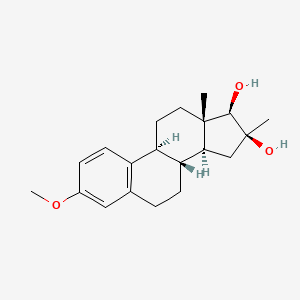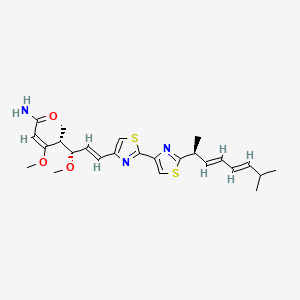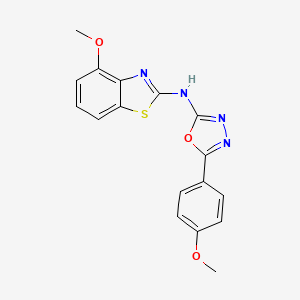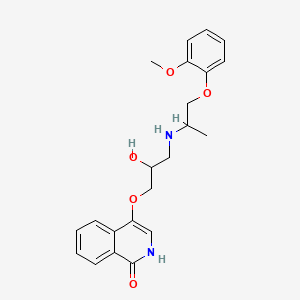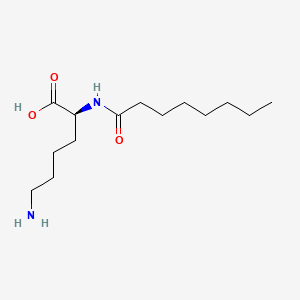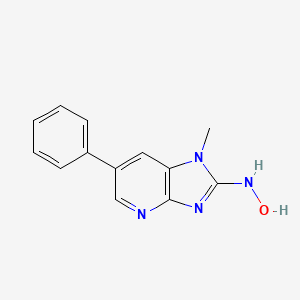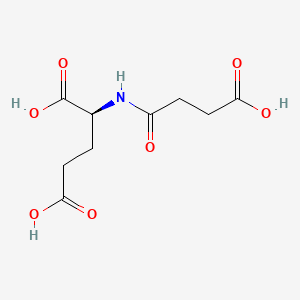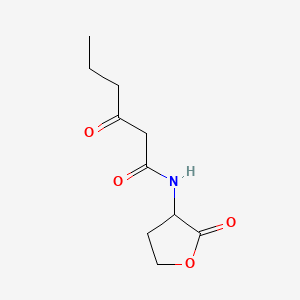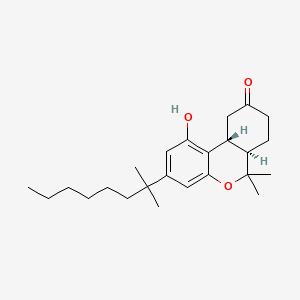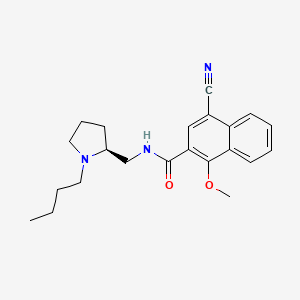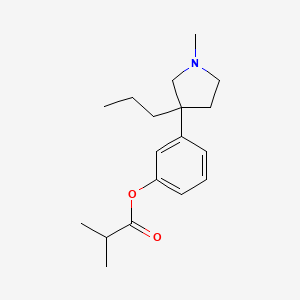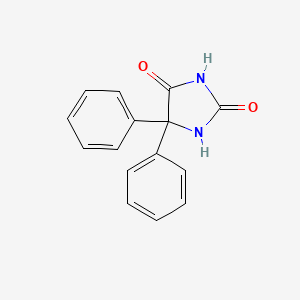
Phenytoin
Vue d'ensemble
Description
Phenytoin is a widely used anticonvulsant medication primarily prescribed for the management of various types of seizures, including tonic-clonic and focal seizures . It was first synthesized in 1908 by the German chemist Heinrich Biltz and later found to be effective for seizure control in 1936 . This compound is also known for its applications in treating certain heart arrhythmias and neuropathic pain .
Méthodes De Préparation
Synthetic Routes and Reaction Conditions: Phenytoin can be synthesized through a base-catalyzed reaction between benzil and urea. The reaction involves the following steps :
- Combine 5.3 grams of benzil, 3.0 grams of urea, 15 milliliters of aqueous sodium hydroxide solution (30%), and 75 milliliters of ethanol in a round-bottomed flask.
- Set up a reflux condenser and boil the mixture using an electric heating mantle for at least 2 hours.
- Cool the mixture to room temperature to obtain this compound.
Industrial Production Methods: In industrial settings, this compound is often produced using mechanochemical methods, which involve the use of ball milling to facilitate the reaction between benzil, urea, and potassium hydroxide . This method is advantageous due to its simplicity, effectiveness, and sustainability .
Analyse Des Réactions Chimiques
Phenytoin undergoes various chemical reactions, including:
Reduction: this compound can be reduced to its corresponding dihydrodiol derivative.
Substitution: this compound can undergo substitution reactions, particularly in the presence of strong nucleophiles.
Common reagents and conditions used in these reactions include sodium hydroxide, ethanol, and potassium hydroxide . The major products formed from these reactions are hydroxylated and dihydrodiol derivatives .
Applications De Recherche Scientifique
Phenytoin has a wide range of scientific research applications, including:
Mécanisme D'action
Phenytoin exerts its effects by inhibiting voltage-gated sodium channels in neurons, thereby stabilizing neuronal membranes and preventing the spread of seizure activity . It reduces the influx of sodium ions during depolarization, which decreases the excitability of neurons and prevents the initiation and propagation of seizures . This compound also affects other ion channels and neurotransmitter systems, contributing to its anticonvulsant and antiarrhythmic properties .
Comparaison Avec Des Composés Similaires
Phenytoin is often compared with other anticonvulsant medications, such as:
Phenobarbital: this compound has a higher anticonvulsant activity and lower hypnotic effects compared to phenobarbital.
This compound’s uniqueness lies in its specific inhibition of voltage-gated sodium channels, which distinguishes it from other anticonvulsants that may target different ion channels or neurotransmitter systems .
Propriétés
IUPAC Name |
5,5-diphenylimidazolidine-2,4-dione | |
|---|---|---|
| Source | PubChem | |
| URL | https://pubchem.ncbi.nlm.nih.gov | |
| Description | Data deposited in or computed by PubChem | |
InChI |
InChI=1S/C15H12N2O2/c18-13-15(17-14(19)16-13,11-7-3-1-4-8-11)12-9-5-2-6-10-12/h1-10H,(H2,16,17,18,19) | |
| Source | PubChem | |
| URL | https://pubchem.ncbi.nlm.nih.gov | |
| Description | Data deposited in or computed by PubChem | |
InChI Key |
CXOFVDLJLONNDW-UHFFFAOYSA-N | |
| Source | PubChem | |
| URL | https://pubchem.ncbi.nlm.nih.gov | |
| Description | Data deposited in or computed by PubChem | |
Canonical SMILES |
C1=CC=C(C=C1)C2(C(=O)NC(=O)N2)C3=CC=CC=C3 | |
| Source | PubChem | |
| URL | https://pubchem.ncbi.nlm.nih.gov | |
| Description | Data deposited in or computed by PubChem | |
Molecular Formula |
C15H12N2O2 | |
| Record name | PHENYTOIN | |
| Source | CAMEO Chemicals | |
| URL | https://cameochemicals.noaa.gov/chemical/18194 | |
| Description | CAMEO Chemicals is a chemical database designed for people who are involved in hazardous material incident response and planning. CAMEO Chemicals contains a library with thousands of datasheets containing response-related information and recommendations for hazardous materials that are commonly transported, used, or stored in the United States. CAMEO Chemicals was developed by the National Oceanic and Atmospheric Administration's Office of Response and Restoration in partnership with the Environmental Protection Agency's Office of Emergency Management. | |
| Explanation | CAMEO Chemicals and all other CAMEO products are available at no charge to those organizations and individuals (recipients) responsible for the safe handling of chemicals. However, some of the chemical data itself is subject to the copyright restrictions of the companies or organizations that provided the data. | |
| Record name | phenytoin | |
| Source | Wikipedia | |
| URL | https://en.wikipedia.org/wiki/Phenytoin | |
| Description | Chemical information link to Wikipedia. | |
| Source | PubChem | |
| URL | https://pubchem.ncbi.nlm.nih.gov | |
| Description | Data deposited in or computed by PubChem | |
DSSTOX Substance ID |
DTXSID8020541 | |
| Record name | 5,5-Diphenylhydantoin | |
| Source | EPA DSSTox | |
| URL | https://comptox.epa.gov/dashboard/DTXSID8020541 | |
| Description | DSSTox provides a high quality public chemistry resource for supporting improved predictive toxicology. | |
Molecular Weight |
252.27 g/mol | |
| Source | PubChem | |
| URL | https://pubchem.ncbi.nlm.nih.gov | |
| Description | Data deposited in or computed by PubChem | |
Physical Description |
Phenytoin appears as fine white or almost white crystalline powder. Odorless or almost odorless. Tasteless. (NTP, 1992), Solid | |
| Record name | PHENYTOIN | |
| Source | CAMEO Chemicals | |
| URL | https://cameochemicals.noaa.gov/chemical/18194 | |
| Description | CAMEO Chemicals is a chemical database designed for people who are involved in hazardous material incident response and planning. CAMEO Chemicals contains a library with thousands of datasheets containing response-related information and recommendations for hazardous materials that are commonly transported, used, or stored in the United States. CAMEO Chemicals was developed by the National Oceanic and Atmospheric Administration's Office of Response and Restoration in partnership with the Environmental Protection Agency's Office of Emergency Management. | |
| Explanation | CAMEO Chemicals and all other CAMEO products are available at no charge to those organizations and individuals (recipients) responsible for the safe handling of chemicals. However, some of the chemical data itself is subject to the copyright restrictions of the companies or organizations that provided the data. | |
| Record name | Phenytoin | |
| Source | Human Metabolome Database (HMDB) | |
| URL | http://www.hmdb.ca/metabolites/HMDB0014397 | |
| Description | The Human Metabolome Database (HMDB) is a freely available electronic database containing detailed information about small molecule metabolites found in the human body. | |
| Explanation | HMDB is offered to the public as a freely available resource. Use and re-distribution of the data, in whole or in part, for commercial purposes requires explicit permission of the authors and explicit acknowledgment of the source material (HMDB) and the original publication (see the HMDB citing page). We ask that users who download significant portions of the database cite the HMDB paper in any resulting publications. | |
Solubility |
>37.8 [ug/mL] (The mean of the results at pH 7.4), less than 0.1 mg/mL at 66 °F (NTP, 1992), Insoluble in cold water, One gram dissolves in about 60 ml alcohol, about 30 ml acetone. Soluble in alkali hydroxides., Soluble in acetic acid; slightly soluble in ethyl ether, benzene, chloroform, In water, 32 mg/L at 22 °C, 7.11e-02 g/L | |
| Record name | SID11532994 | |
| Source | Burnham Center for Chemical Genomics | |
| URL | https://pubchem.ncbi.nlm.nih.gov/bioassay/1996#section=Data-Table | |
| Description | Aqueous solubility in buffer at pH 7.4 | |
| Record name | PHENYTOIN | |
| Source | CAMEO Chemicals | |
| URL | https://cameochemicals.noaa.gov/chemical/18194 | |
| Description | CAMEO Chemicals is a chemical database designed for people who are involved in hazardous material incident response and planning. CAMEO Chemicals contains a library with thousands of datasheets containing response-related information and recommendations for hazardous materials that are commonly transported, used, or stored in the United States. CAMEO Chemicals was developed by the National Oceanic and Atmospheric Administration's Office of Response and Restoration in partnership with the Environmental Protection Agency's Office of Emergency Management. | |
| Explanation | CAMEO Chemicals and all other CAMEO products are available at no charge to those organizations and individuals (recipients) responsible for the safe handling of chemicals. However, some of the chemical data itself is subject to the copyright restrictions of the companies or organizations that provided the data. | |
| Record name | Phenytoin | |
| Source | DrugBank | |
| URL | https://www.drugbank.ca/drugs/DB00252 | |
| Description | The DrugBank database is a unique bioinformatics and cheminformatics resource that combines detailed drug (i.e. chemical, pharmacological and pharmaceutical) data with comprehensive drug target (i.e. sequence, structure, and pathway) information. | |
| Explanation | Creative Common's Attribution-NonCommercial 4.0 International License (http://creativecommons.org/licenses/by-nc/4.0/legalcode) | |
| Record name | PHENYTOIN | |
| Source | Hazardous Substances Data Bank (HSDB) | |
| URL | https://pubchem.ncbi.nlm.nih.gov/source/hsdb/3160 | |
| Description | The Hazardous Substances Data Bank (HSDB) is a toxicology database that focuses on the toxicology of potentially hazardous chemicals. It provides information on human exposure, industrial hygiene, emergency handling procedures, environmental fate, regulatory requirements, nanomaterials, and related areas. The information in HSDB has been assessed by a Scientific Review Panel. | |
| Record name | Phenytoin | |
| Source | Human Metabolome Database (HMDB) | |
| URL | http://www.hmdb.ca/metabolites/HMDB0014397 | |
| Description | The Human Metabolome Database (HMDB) is a freely available electronic database containing detailed information about small molecule metabolites found in the human body. | |
| Explanation | HMDB is offered to the public as a freely available resource. Use and re-distribution of the data, in whole or in part, for commercial purposes requires explicit permission of the authors and explicit acknowledgment of the source material (HMDB) and the original publication (see the HMDB citing page). We ask that users who download significant portions of the database cite the HMDB paper in any resulting publications. | |
Mechanism of Action |
Although phenytoin first appeared in the literature in 1946, it has taken decades for the mechanism of action to be more specifically elucidated. Although several scientists were convinced that phenytoin altered sodium permeability, it wasn’t until the 1980’s that this phenomenon was linked to voltage-gated sodium channels. Phenytoin is often described as a non-specific sodium channel blocker and targets almost all voltage-gated sodium channel subtypes. More specifically, phenytoin prevents seizures by inhibiting the positive feedback loop that results in neuronal propagation of high frequency action potentials., The mechanism of action is not completely known, but it is thought to involve stabilization of neuronal membranes at the cell body, axon, and synapse and limitation of the spread of neuronal or seizure activity. In neurons, phenytoin decreases sodium and calcium ion influx by prolonging channel inactivation time during generation of nerve impulses. Phenytoin blocks the voltage-dependant sodium channels of neurons and inhibits the calcium flux across neuronal membranes, thus helping to stabilize neurons. It also decreases synaptic transmission, and decreases post-tetanic potentiation at the synapse. Phenytoin enhances the sodium ATPase activity of neurons and/or glial cells. It also influences second messenger systems by inhibiting calcium-calmodulin protein phosphorylation and possibly altering cyclic nucleotide production or metabolism., Phenytoin may act to normalize influx of sodium and calcium to cardiac Purkinje fibers. Abnormal ventricular automaticity and membrane responsiveness are decreased. Also, phenytoin shortens the refractory period, and therefore shortens the QT interval and the duration of the action potential., Exact mechanism is unknown. Phenytoin may act in the CNS to decrease synaptic transmission or to decrease summation of temporal stimulation leading to neuronal discharge (antikindling). Phenytoin raises the threshold of facial pain and shortens the duration of attacks by diminishing self-maintenance of excitation and repetitive firing., Phenytoin's mechanisms of action as a muscle relaxant is thought to be similar to its anticonvulsant action. In movement disorders, the membrane stabilizing effect reduces abnormal sustained repetitive firing and potentiation of nerve and muscle cells., A number of studies suggest that keratinocyte growth factor (KGF) plays a major part in reepithelialization after injury, via binding to the specific KGF receptor (KGFR). Several pharmacological agents, including the anti-epileptic drug phenytoin (PHT), have been widely used clinically to promote wound healing. Although the mechanism of action of PHT in this process is still not well understood, it is possible that the activity of PHT in wound healing is mediated via KGF and the KGFR. In the present study, using the enzyme-linked immunosorbant assay and flow cytometry we have shown that PHT increases KGF secretion and KGFR expression by more than 150% in gingival fibroblasts and epithelial cells, respectively. Moreover, semi-quantitative reverse transcriptase-polymerase chain reaction analysis showed that PHT also markedly increased both KGF and KGFR gene transcription by these cells. | |
| Record name | Phenytoin | |
| Source | DrugBank | |
| URL | https://www.drugbank.ca/drugs/DB00252 | |
| Description | The DrugBank database is a unique bioinformatics and cheminformatics resource that combines detailed drug (i.e. chemical, pharmacological and pharmaceutical) data with comprehensive drug target (i.e. sequence, structure, and pathway) information. | |
| Explanation | Creative Common's Attribution-NonCommercial 4.0 International License (http://creativecommons.org/licenses/by-nc/4.0/legalcode) | |
| Record name | PHENYTOIN | |
| Source | Hazardous Substances Data Bank (HSDB) | |
| URL | https://pubchem.ncbi.nlm.nih.gov/source/hsdb/3160 | |
| Description | The Hazardous Substances Data Bank (HSDB) is a toxicology database that focuses on the toxicology of potentially hazardous chemicals. It provides information on human exposure, industrial hygiene, emergency handling procedures, environmental fate, regulatory requirements, nanomaterials, and related areas. The information in HSDB has been assessed by a Scientific Review Panel. | |
Color/Form |
Needles (alcohol), White powder | |
CAS No. |
57-41-0, 630-93-3 | |
| Record name | PHENYTOIN | |
| Source | CAMEO Chemicals | |
| URL | https://cameochemicals.noaa.gov/chemical/18194 | |
| Description | CAMEO Chemicals is a chemical database designed for people who are involved in hazardous material incident response and planning. CAMEO Chemicals contains a library with thousands of datasheets containing response-related information and recommendations for hazardous materials that are commonly transported, used, or stored in the United States. CAMEO Chemicals was developed by the National Oceanic and Atmospheric Administration's Office of Response and Restoration in partnership with the Environmental Protection Agency's Office of Emergency Management. | |
| Explanation | CAMEO Chemicals and all other CAMEO products are available at no charge to those organizations and individuals (recipients) responsible for the safe handling of chemicals. However, some of the chemical data itself is subject to the copyright restrictions of the companies or organizations that provided the data. | |
| Record name | Phenytoin | |
| Source | CAS Common Chemistry | |
| URL | https://commonchemistry.cas.org/detail?cas_rn=57-41-0 | |
| Description | CAS Common Chemistry is an open community resource for accessing chemical information. Nearly 500,000 chemical substances from CAS REGISTRY cover areas of community interest, including common and frequently regulated chemicals, and those relevant to high school and undergraduate chemistry classes. This chemical information, curated by our expert scientists, is provided in alignment with our mission as a division of the American Chemical Society. | |
| Explanation | The data from CAS Common Chemistry is provided under a CC-BY-NC 4.0 license, unless otherwise stated. | |
| Record name | Phenytoin [USAN:USP:INN:BAN:JAN] | |
| Source | ChemIDplus | |
| URL | https://pubchem.ncbi.nlm.nih.gov/substance/?source=chemidplus&sourceid=0000057410 | |
| Description | ChemIDplus is a free, web search system that provides access to the structure and nomenclature authority files used for the identification of chemical substances cited in National Library of Medicine (NLM) databases, including the TOXNET system. | |
| Record name | Phenytoin | |
| Source | DrugBank | |
| URL | https://www.drugbank.ca/drugs/DB00252 | |
| Description | The DrugBank database is a unique bioinformatics and cheminformatics resource that combines detailed drug (i.e. chemical, pharmacological and pharmaceutical) data with comprehensive drug target (i.e. sequence, structure, and pathway) information. | |
| Explanation | Creative Common's Attribution-NonCommercial 4.0 International License (http://creativecommons.org/licenses/by-nc/4.0/legalcode) | |
| Record name | phenytoin | |
| Source | DTP/NCI | |
| URL | https://dtp.cancer.gov/dtpstandard/servlet/dwindex?searchtype=NSC&outputformat=html&searchlist=8722 | |
| Description | The NCI Development Therapeutics Program (DTP) provides services and resources to the academic and private-sector research communities worldwide to facilitate the discovery and development of new cancer therapeutic agents. | |
| Explanation | Unless otherwise indicated, all text within NCI products is free of copyright and may be reused without our permission. Credit the National Cancer Institute as the source. | |
| Record name | 5,5-Diphenylhydantoin | |
| Source | EPA DSSTox | |
| URL | https://comptox.epa.gov/dashboard/DTXSID8020541 | |
| Description | DSSTox provides a high quality public chemistry resource for supporting improved predictive toxicology. | |
| Record name | Phenytoin | |
| Source | European Chemicals Agency (ECHA) | |
| URL | https://echa.europa.eu/substance-information/-/substanceinfo/100.000.298 | |
| Description | The European Chemicals Agency (ECHA) is an agency of the European Union which is the driving force among regulatory authorities in implementing the EU's groundbreaking chemicals legislation for the benefit of human health and the environment as well as for innovation and competitiveness. | |
| Explanation | Use of the information, documents and data from the ECHA website is subject to the terms and conditions of this Legal Notice, and subject to other binding limitations provided for under applicable law, the information, documents and data made available on the ECHA website may be reproduced, distributed and/or used, totally or in part, for non-commercial purposes provided that ECHA is acknowledged as the source: "Source: European Chemicals Agency, http://echa.europa.eu/". Such acknowledgement must be included in each copy of the material. ECHA permits and encourages organisations and individuals to create links to the ECHA website under the following cumulative conditions: Links can only be made to webpages that provide a link to the Legal Notice page. | |
| Record name | Phenytoin sodium | |
| Source | European Chemicals Agency (ECHA) | |
| URL | https://echa.europa.eu/substance-information/-/substanceinfo/100.010.136 | |
| Description | The European Chemicals Agency (ECHA) is an agency of the European Union which is the driving force among regulatory authorities in implementing the EU's groundbreaking chemicals legislation for the benefit of human health and the environment as well as for innovation and competitiveness. | |
| Explanation | Use of the information, documents and data from the ECHA website is subject to the terms and conditions of this Legal Notice, and subject to other binding limitations provided for under applicable law, the information, documents and data made available on the ECHA website may be reproduced, distributed and/or used, totally or in part, for non-commercial purposes provided that ECHA is acknowledged as the source: "Source: European Chemicals Agency, http://echa.europa.eu/". Such acknowledgement must be included in each copy of the material. ECHA permits and encourages organisations and individuals to create links to the ECHA website under the following cumulative conditions: Links can only be made to webpages that provide a link to the Legal Notice page. | |
| Record name | PHENYTOIN | |
| Source | FDA Global Substance Registration System (GSRS) | |
| URL | https://gsrs.ncats.nih.gov/ginas/app/beta/substances/6158TKW0C5 | |
| Description | The FDA Global Substance Registration System (GSRS) enables the efficient and accurate exchange of information on what substances are in regulated products. Instead of relying on names, which vary across regulatory domains, countries, and regions, the GSRS knowledge base makes it possible for substances to be defined by standardized, scientific descriptions. | |
| Explanation | Unless otherwise noted, the contents of the FDA website (www.fda.gov), both text and graphics, are not copyrighted. They are in the public domain and may be republished, reprinted and otherwise used freely by anyone without the need to obtain permission from FDA. Credit to the U.S. Food and Drug Administration as the source is appreciated but not required. | |
| Record name | PHENYTOIN | |
| Source | Hazardous Substances Data Bank (HSDB) | |
| URL | https://pubchem.ncbi.nlm.nih.gov/source/hsdb/3160 | |
| Description | The Hazardous Substances Data Bank (HSDB) is a toxicology database that focuses on the toxicology of potentially hazardous chemicals. It provides information on human exposure, industrial hygiene, emergency handling procedures, environmental fate, regulatory requirements, nanomaterials, and related areas. The information in HSDB has been assessed by a Scientific Review Panel. | |
| Record name | Phenytoin | |
| Source | Human Metabolome Database (HMDB) | |
| URL | http://www.hmdb.ca/metabolites/HMDB0014397 | |
| Description | The Human Metabolome Database (HMDB) is a freely available electronic database containing detailed information about small molecule metabolites found in the human body. | |
| Explanation | HMDB is offered to the public as a freely available resource. Use and re-distribution of the data, in whole or in part, for commercial purposes requires explicit permission of the authors and explicit acknowledgment of the source material (HMDB) and the original publication (see the HMDB citing page). We ask that users who download significant portions of the database cite the HMDB paper in any resulting publications. | |
Melting Point |
563 to 568 °F (NTP, 1992), 295-298 °C, 286 °C | |
| Record name | PHENYTOIN | |
| Source | CAMEO Chemicals | |
| URL | https://cameochemicals.noaa.gov/chemical/18194 | |
| Description | CAMEO Chemicals is a chemical database designed for people who are involved in hazardous material incident response and planning. CAMEO Chemicals contains a library with thousands of datasheets containing response-related information and recommendations for hazardous materials that are commonly transported, used, or stored in the United States. CAMEO Chemicals was developed by the National Oceanic and Atmospheric Administration's Office of Response and Restoration in partnership with the Environmental Protection Agency's Office of Emergency Management. | |
| Explanation | CAMEO Chemicals and all other CAMEO products are available at no charge to those organizations and individuals (recipients) responsible for the safe handling of chemicals. However, some of the chemical data itself is subject to the copyright restrictions of the companies or organizations that provided the data. | |
| Record name | Phenytoin | |
| Source | DrugBank | |
| URL | https://www.drugbank.ca/drugs/DB00252 | |
| Description | The DrugBank database is a unique bioinformatics and cheminformatics resource that combines detailed drug (i.e. chemical, pharmacological and pharmaceutical) data with comprehensive drug target (i.e. sequence, structure, and pathway) information. | |
| Explanation | Creative Common's Attribution-NonCommercial 4.0 International License (http://creativecommons.org/licenses/by-nc/4.0/legalcode) | |
| Record name | PHENYTOIN | |
| Source | Hazardous Substances Data Bank (HSDB) | |
| URL | https://pubchem.ncbi.nlm.nih.gov/source/hsdb/3160 | |
| Description | The Hazardous Substances Data Bank (HSDB) is a toxicology database that focuses on the toxicology of potentially hazardous chemicals. It provides information on human exposure, industrial hygiene, emergency handling procedures, environmental fate, regulatory requirements, nanomaterials, and related areas. The information in HSDB has been assessed by a Scientific Review Panel. | |
| Record name | Phenytoin | |
| Source | Human Metabolome Database (HMDB) | |
| URL | http://www.hmdb.ca/metabolites/HMDB0014397 | |
| Description | The Human Metabolome Database (HMDB) is a freely available electronic database containing detailed information about small molecule metabolites found in the human body. | |
| Explanation | HMDB is offered to the public as a freely available resource. Use and re-distribution of the data, in whole or in part, for commercial purposes requires explicit permission of the authors and explicit acknowledgment of the source material (HMDB) and the original publication (see the HMDB citing page). We ask that users who download significant portions of the database cite the HMDB paper in any resulting publications. | |
Retrosynthesis Analysis
AI-Powered Synthesis Planning: Our tool employs the Template_relevance Pistachio, Template_relevance Bkms_metabolic, Template_relevance Pistachio_ringbreaker, Template_relevance Reaxys, Template_relevance Reaxys_biocatalysis model, leveraging a vast database of chemical reactions to predict feasible synthetic routes.
One-Step Synthesis Focus: Specifically designed for one-step synthesis, it provides concise and direct routes for your target compounds, streamlining the synthesis process.
Accurate Predictions: Utilizing the extensive PISTACHIO, BKMS_METABOLIC, PISTACHIO_RINGBREAKER, REAXYS, REAXYS_BIOCATALYSIS database, our tool offers high-accuracy predictions, reflecting the latest in chemical research and data.
Strategy Settings
| Precursor scoring | Relevance Heuristic |
|---|---|
| Min. plausibility | 0.01 |
| Model | Template_relevance |
| Template Set | Pistachio/Bkms_metabolic/Pistachio_ringbreaker/Reaxys/Reaxys_biocatalysis |
| Top-N result to add to graph | 6 |
Feasible Synthetic Routes
Q1: How does phenytoin exert its anticonvulsant effect?
A1: this compound primarily acts by stabilizing neuronal membranes and reducing neuronal hyperexcitability. It does this by blocking voltage-gated sodium channels, which are essential for the generation and propagation of action potentials in neurons [, , ]. This effectively raises the seizure threshold and reduces the spread of seizure activity. While an early hypothesis suggested a link between this compound's anticonvulsant effect and increased spontaneous firing of cerebellar Purkinje cells, a study on frogs failed to support this theory [].
Q2: Does this compound influence calcium signaling pathways?
A2: Yes, research suggests that this compound can influence calcium signaling pathways. A study on PC12 pheochromocytoma cells demonstrated that this compound inhibits voltage-gated calcium flux, similar to classical calcium channel antagonists, but through a distinct mechanism []. This effect on calcium channels could contribute to its anticonvulsant and other pharmacological properties. Another study demonstrated that this compound may inhibit calcium-mediated phenomena, particularly the inositol cycle, in cerebral ischemia, potentially contributing to its neuroprotective effects [].
Q3: What is the molecular formula and weight of this compound?
A3: The molecular formula of this compound is C15H12N2O2, and its molecular weight is 252.27 g/mol.
Q4: Are there any prodrugs of this compound, and how do they differ in their properties?
A5: Yes, several prodrugs of this compound have been developed, aiming to improve its water solubility and bioavailability [, ]. One notable example is fosthis compound, a water-soluble phosphate ester prodrug that is converted to this compound in vivo [, , ]. Fosthis compound offers advantages for parenteral administration due to its enhanced solubility, reducing the risk of precipitation and tissue irritation associated with intravenous this compound [, ].
Q5: What factors can affect the stability of this compound formulations?
A6: this compound can degrade under certain conditions, particularly in the presence of acidic pH []. To improve its stability, formulations often utilize strategies like pH adjustment and complexation with cyclodextrins, such as (SBE)7m-beta-CD []. These approaches enhance solubility and prevent precipitation, leading to a longer shelf life for fosthis compound formulations [].
Q6: Describe the absorption of this compound.
A7: this compound exhibits variable and unpredictable absorption when administered orally, potentially influenced by factors like food intake, formulation, and individual patient characteristics [, ].
Q7: How is this compound metabolized in the body?
A8: this compound is primarily metabolized in the liver by cytochrome P450 enzymes, mainly CYP2C9, into its major inactive metabolite, 5-(para-hydroxyphenyl)-5-phenylhydantoin (HPPH) [, , , , ].
Q8: What are the routes of elimination for this compound and its metabolites?
A9: this compound and its metabolites are primarily eliminated through urine, with a small portion excreted in bile [, ]. The extent of urinary excretion of HPPH, both conjugated and unconjugated forms, can vary among individuals, and autoinduction of this compound metabolism may influence the proportion of the dose excreted as HPPH [].
Q9: How does hypoalbuminemia affect this compound levels?
A10: this compound is highly protein-bound, primarily to albumin [, , ]. In conditions like hypoalbuminemia, common in critically ill patients, the free fraction of this compound increases, potentially leading to toxicity even with total this compound concentrations within the therapeutic range [, , ].
Q10: Is there a difference between total and free this compound levels, and how do they relate to toxicity?
A11: Yes, total this compound levels reflect both protein-bound and unbound (free) drug, while free this compound levels represent the pharmacologically active fraction [, , ]. While total this compound levels are commonly measured, they may not accurately reflect the free drug concentration, especially in patients with altered protein binding [, , ]. Free this compound levels are a better indicator of potential toxicity [, , ].
Q11: How do this compound's pharmacokinetics change during pregnancy and in newborns?
A12: this compound readily crosses the placenta, potentially affecting fetal development and leading to neonatal complications []. Studies on newborn infants of epileptic mothers treated with this compound during pregnancy show that the drug's kinetics can vary significantly in newborns, with different elimination patterns observed []. Additionally, the plasma concentration of unconjugated HPPH, a major this compound metabolite, tends to remain relatively stable in newborns during the first few days of life [].
Q12: What is the significance of this compound's narrow therapeutic index?
A13: this compound has a narrow therapeutic index, meaning that the therapeutic range for effective seizure control is close to the concentration that can cause toxicity [, , ]. This necessitates careful dosage adjustments and therapeutic drug monitoring to ensure efficacy and minimize adverse effects.
Q13: What mechanisms contribute to this compound resistance in epilepsy?
A14: While the exact mechanisms of this compound resistance are not fully understood, research suggests that overexpression of P-glycoprotein (P-gp), a drug efflux transporter, in the brain might play a role []. P-gp can pump this compound out of brain cells, reducing its intracellular concentration and potentially diminishing its anticonvulsant effect [].
Q14: Do genetic variations in P-glycoprotein affect this compound's effectiveness?
A15: Studies investigating the impact of two common single nucleotide polymorphisms (SNPs) in the P-gp gene (2677G>T and 3435C>T) on this compound pharmacokinetics have shown that individuals with the T/T2677T/T3435 haplotype might have slightly higher bioavailability of this compound compared to those with the G/G2677C/C3435 haplotype []. While these SNPs didn't significantly affect overall drug exposure (AUC) or peak concentration (Cmax), they may influence the time to reach peak concentration, potentially influencing the drug's effectiveness in refractory epilepsy patients [].
Q15: What are some common adverse effects associated with this compound?
A16: this compound is known to have a wide range of potential adverse effects, including those affecting the central nervous system (e.g., dizziness, ataxia, nystagmus), gastrointestinal system (e.g., nausea, vomiting), skin (e.g., rash, gingival hyperplasia), and blood cells (e.g., thrombocytopenia, leukopenia) [, , , , , , ].
Q16: Are there any reported cases of this compound-induced hypersensitivity reactions in newborns?
A17: While rare, this compound-induced hypersensitivity reactions have been reported in neonates []. These reactions can manifest as skin rashes and, if severe, may lead to life-threatening complications. Strict clinical monitoring, especially in vulnerable populations like newborns, is crucial to promptly identify and manage such reactions [].
Q17: Can this compound overdose lead to serious cardiac complications?
A18: Yes, both intravenous and oral this compound overdose can lead to severe cardiac adverse effects []. A case report highlighted a patient with chronic oral this compound overdose who developed life-threatening junctional bradycardia requiring pacemaker implantation []. This emphasizes the need for careful monitoring of this compound levels and awareness of potential toxicity, even with oral administration.
Q18: Does this compound interact with other drugs?
A19: Yes, this compound is known to interact with numerous drugs due to its effects on cytochrome P450 enzymes and protein binding. It can both induce and inhibit the metabolism of other drugs, leading to either increased or decreased serum concentrations of the co-administered medications [, , , ].
Q19: How does this compound affect lipid metabolism and cardiovascular risk factors?
A20: Studies on young Indian adults with epilepsy indicated that long-term this compound treatment could exacerbate dyslipidemia, particularly by increasing LDL-cholesterol and decreasing HDL-cholesterol []. Additionally, this compound was associated with increased body mass index, suggesting a potential impact on metabolic health and cardiovascular risk factors [].
Q20: What strategies are employed to improve the solubility of this compound?
A21: this compound's limited water solubility poses challenges for formulation and administration. Prodrug strategies, such as the development of fosthis compound, utilize phosphate esterification to enhance water solubility, making it more suitable for parenteral administration [, , ]. Additionally, complexation with cyclodextrins like (SBE)7m-beta-CD has been explored to improve this compound's solubility and stability in formulations, potentially enhancing its bioavailability [].
Q21: How does this compound interact with drug transporters?
A22: this compound is a substrate of P-glycoprotein (P-gp), an efflux transporter expressed in various tissues, including the intestine, liver, and brain []. P-gp can limit the absorption and distribution of this compound by pumping it out of cells, potentially affecting its bioavailability and efficacy, especially in the central nervous system [].
Q22: Are there alternative antiepileptic drugs to this compound?
A23: Yes, several alternative antiepileptic drugs are available, each with its own mechanism of action, efficacy, and safety profile [, , ]. Common alternatives include carbamazepine, valproic acid, levetiracetam, gabapentin, and lamotrigine [, , ]. The choice of antiepileptic drug depends on factors like seizure type, patient characteristics, potential drug interactions, and individual response to treatment [, , ].
Avertissement et informations sur les produits de recherche in vitro
Veuillez noter que tous les articles et informations sur les produits présentés sur BenchChem sont destinés uniquement à des fins informatives. Les produits disponibles à l'achat sur BenchChem sont spécifiquement conçus pour des études in vitro, qui sont réalisées en dehors des organismes vivants. Les études in vitro, dérivées du terme latin "in verre", impliquent des expériences réalisées dans des environnements de laboratoire contrôlés à l'aide de cellules ou de tissus. Il est important de noter que ces produits ne sont pas classés comme médicaments et n'ont pas reçu l'approbation de la FDA pour la prévention, le traitement ou la guérison de toute condition médicale, affection ou maladie. Nous devons souligner que toute forme d'introduction corporelle de ces produits chez les humains ou les animaux est strictement interdite par la loi. Il est essentiel de respecter ces directives pour assurer la conformité aux normes légales et éthiques en matière de recherche et d'expérimentation.


